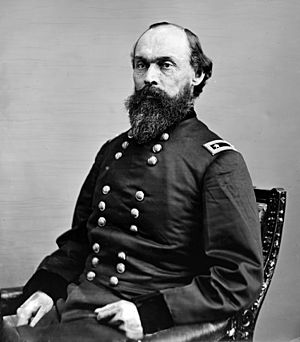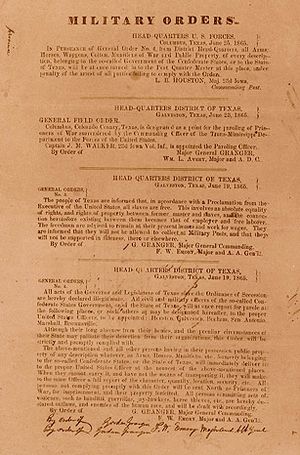Gordon Granger facts for kids
Quick facts for kids
Gordon Granger
|
|
|---|---|

Gordon Granger, photo taken during American Civil War
|
|
| Born | November 6, 1821 Joy, New York, US |
| Died | January 10, 1876 (aged 54) Santa Fe, New Mexico, US |
| Place of burial |
Lexington Cemetery, Lexington, Kentucky, US
|
| Allegiance | United States |
| Service/ |
United States Army (Union Army) |
| Years of service | 1845–1876 |
| Rank | Major general |
| Commands held | Army of Kentucky IV Corps XIII Corps Department of Texas District of New Mexico |
| Battles/wars | |
Gordon Granger (born November 6, 1821 – died January 10, 1876) was an officer in the United States Army. He became a general for the Union Army during the American Civil War. He is especially remembered for his brave actions at the Battle of Chickamauga. He is also famous for announcing General Order No. 3 in Texas, which helped spread the news of freedom for enslaved people. This event is now celebrated as Juneteenth.
Contents
Early Life and Military Start
Growing Up
Gordon Granger was born in Joy, Wayne County, New York, in 1821. He was one of three children. After his mother passed away, his father remarried and had ten more children. Gordon spent his early years with his grandparents. He faced some health problems throughout his life. Before joining the military, he worked as a teacher in North Rose, New York.
Joining the Army
In 1841, when he was 19, Granger joined the United States Military Academy at West Point. He graduated in 1845. After West Point, he became a second lieutenant in the Second Infantry Regiment. Later, he moved to the Regiment of Mounted Riflemen.
Fighting in the Mexican-American War
During the Mexican–American War, Granger fought with General Winfield Scott's army. He took part in several important battles, including the Siege of Veracruz and the Battle for Mexico City. He was recognized for his bravery twice. In 1847, he officially became a second lieutenant. After the war, he served on the western frontier in places like Oregon and Texas. He became a first lieutenant in 1853.
The American Civil War
When the American Civil War began, Granger was on sick leave. He soon returned to duty and was promoted to captain in May 1861. He served as a staff officer and saw the Union defeat at the Battle of Wilson's Creek in August 1861. He was praised for his courage there and became a major. He then took command of the St. Louis Arsenal.
In November 1861, Granger became the colonel of the 2nd Michigan Cavalry Regiment. One soldier wrote that Granger quickly trained his men to be as good as regular soldiers. He earned their respect by being very strict and paying attention to every detail.
In February 1862, Granger's regiment moved to Missouri. He soon took command of a cavalry brigade, which later became a cavalry division. On March 26, 1862, he was promoted to brigadier general. He led the Cavalry Division during the Battle of New Madrid and the Siege of Corinth. In September 1862, he became a major general and took command of the Army of Kentucky.

Hero at Chickamauga
Granger is most famous for his actions at the Battle of Chickamauga on September 20, 1863. On the second day of the battle, he saw that Major General George H. Thomas' troops were in trouble. Without waiting for orders, Granger sent two of his brigades to help Thomas on Snodgrass Hill. When Thomas asked if Granger's men could counterattack, Granger said, "My men are fresh and they are just the fellows for that work." This brave move held off the Confederate attacks until nightfall. It allowed the Union forces to retreat safely. Thomas earned the nickname "Rock of Chickamauga" because of this stand.
Later Battles
After Chickamauga, Granger was given command of the new IV Corps. His troops fought well at the Battle of Chattanooga. During the Battle of Missionary Ridge, two of his divisions charged up the steep ridge. Even though they had no orders to go past the base, they kept going and defeated the Confederates at the top. This helped force the Confederates to retreat.
After Chattanooga, Granger helped lift the siege at Knoxville, Tennessee. Later, he was sent to the Department of the Gulf. He led land forces that helped Admiral David Farragut capture Forts Gaines and Morgan during the Battle of Mobile Bay. Granger also led the XIII Corps during the Battle of Fort Blakeley, which led to the capture of Mobile, Alabama.
After the War
Juneteenth in Texas

When the Civil War ended, Granger was put in charge of the District of Texas. On June 19, 1865, he announced General Order No. 3 in Galveston, Texas. This order told everyone that all enslaved people in Texas were now free. This news caused great joy among the newly freed people. This day, June 19, is now celebrated every year as Juneteenth, a federal holiday that remembers the end of slavery in Texas.
Later Military Service
After his time in Texas, Granger continued to serve in the Army. He commanded the Department of Kentucky for a while. In 1866, he became a colonel in the 25th Infantry Regiment. He later commanded the District of New Mexico.
In March 1872, Granger met with Cochise, a leader of the Chiricahua tribe, to discuss peace. While a full peace agreement didn't happen right away, it was an important step. Peace was finally reached later that year with the help of another general.
Gordon Granger died in Santa Fe, New Mexico, on January 10, 1876. He is buried in Lexington Cemetery in Kentucky.
See also
- List of American Civil War generals (Union)

